Dish with 'Kaleidoscope' Design
This dynamically decorated sixteenth-century dish in cobalt blue was produced at the famous kilns at Iznik, in western Anatolia. Stylized variations of lotus petals, ultimately of Chinese inspiration but geometrically patterned into a radiating sunburst of powerful Islamic design, bear witness to one of the most fruitful cultural exchanges in history: the mutual influences flourishing for centuries between the artists, especially potters, of eastern and western Asia. Chinese influences on Islamic art peaked in the thirteenth and fourteenth centuries, when nearly all Asia came under the sway of the Great Khans, the Mongol overlords ruling from Beijing. The Ilkhanids who governed the Near East from their capital at Tabriz, in modern northwestern Iran, imported precious Chinese wares, commanding local Muslim artists to study Chinese technique and design. The sixteenth-century potters of the Ottoman court though set at the westernmost limit of the Asian world, still pursued–and creatively renewed with great flair and pride–the traditions of the Tabriz school.
Artwork Details
- Title: Dish with 'Kaleidoscope' Design
- Date: ca. 1580–85
- Geography: Made in Turkey, Iznik
- Medium: Stonepaste; polychrome painted under transparent glaze
- Dimensions: H. 2 11/16 in. (6.8 cm)
Diam. of rim: 13 3/4 in. (34.9 cm) - Classification: Ceramics
- Credit Line: Gift of Philippe and Edith de Montebello, 1991
- Object Number: 1991.172
- Curatorial Department: Islamic Art
More Artwork
Research Resources
The Met provides unparalleled resources for research and welcomes an international community of students and scholars. The Met's Open Access API is where creators and researchers can connect to the The Met collection. Open Access data and public domain images are available for unrestricted commercial and noncommercial use without permission or fee.
To request images under copyright and other restrictions, please use this Image Request form.
Feedback
We continue to research and examine historical and cultural context for objects in The Met collection. If you have comments or questions about this object record, please contact us using the form below. The Museum looks forward to receiving your comments.
